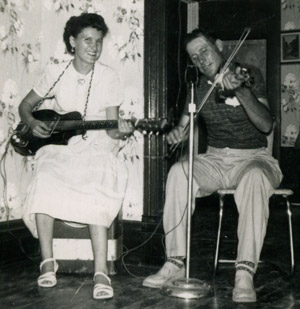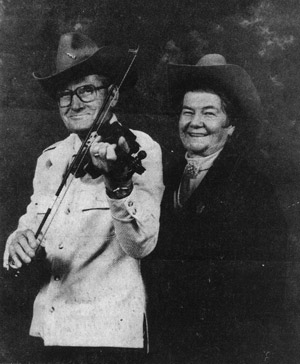by Brad Leftwich and Linda Higginbotham July, 2014
From 1982 to 1986 my wife Linda and I performed at the Mountain Folks Music Festival, held for ten days every June at the Silver Dollar City theme park in Branson, Missouri. It was a great experience, and we met and became friends with traditional musicians from all over Arkansas, Oklahoma, and Missouri. One of the musicians we got to know was Fred Stoneking, who was playing in a bluegrass band but who had grown up with oldtime music and was himself a good old-time fiddler. He liked our banjo and fiddle music and told us he thought we’d enjoy visiting his father, Lee, who he said was one of the best old-time fiddlers around. I tucked it away in the back of my mind for future reference, but it was a casual conversation and I never got specific information about where his dad lived or how to get in touch with him.
Another musician we met at Silver Dollar City was Ivan Meacham, a guitar player with one of the other bands at the festival. Ivan and his wife had a lovely place in the woods near Lowry City, Missouri, and he invited us to stay over any time we were in the area. We took him up on the offer on July 30, 1985, on a trip to a bluegrass festival at Lake of the Ozarks with our new guitar player, Kenny Jackson.
The next day, in the late morning, Ivan said there was someone he wanted us to hear. He took us to a local community center that was hosting a luncheon for senior citizens. When we walked in the door we were surprised to see, on a small stage entertaining the crowd with his fiddling, Lee Stoneking himself. We had no idea he lived in Lowry City, and were delighted to finally meet him.
Lee had recently had his larynx removed due to cancer, and was unable to speak, but he graciously beckoned us up on stage to play with him. Kenny played guitar, I played five-string banjo, and Linda played banjo-uke and ran the tape recorder. There was a sound system with a couple of microphones, and Lee was using an electronic pickup on his fiddle which gave it kind of a tinny sound. But the music was wonderful! His playing wasn’t fast, but it was smooth and clean with elegant bowing, rock-solid timing, and tasteful and distinctive arrangements of tunes. We played for maybe an hour, until it looked like the luncheon was about to end. They gave us all a free lunch for helping to entertain, and Lee and his wife Thelma invited us to come out to their home afterwards for more music.
It was a beautiful day, and we played music for a couple of hours more on their porch that afternoon. When we first arrived, Lee got out an old open-backed banjo with stubborn friction tuners, and after wrestling it into tune, treated us to a number of tunes in a solid, not fancy, but very rhythmic up-picking style. Then, at Thelma’s urging, he got his fiddle again and played some more of those beautifully crafted tunes. Linda got it all on tape, and this time the acoustic sound of his fiddle was a big improvement over the electronic pickup. At some point Linda went for a walk and I switched from five-string to banjo-uke ― much less stressful for trying to follow tunes I didn’t know!
Between tunes we tried to communicate. Usually with a combination of whispering, pantomime, and scribbled notes Lee could make himself understood, but it was difficult and we missed the names of several of the tunes (most of which have since been identified). Thelma beamed with pride and told us stories of Lee’s triumphs at fiddle contests and the esteem in which other musicians held him. Lee returned her affection, and when we bought his three LPs he autographed them all: “Lee Stoneking and Thelma, my wife.”
Lee also made fiddles in a workshop he had set up in a trailer near the house. He stored his boxes of LPs in the trailer as well, and when he went to retrieve the records he showed us the workshop and some of the fiddles he made.
The time came for us to leave, and we reluctantly packed up our instruments. We vowed to return for another visit someday, but unfortunately were never able to make good our intentions. We’re glad, though, that we made recordings of this master musician, and happy to have this opportunity to share them with other fans of traditional old-time fiddling.


